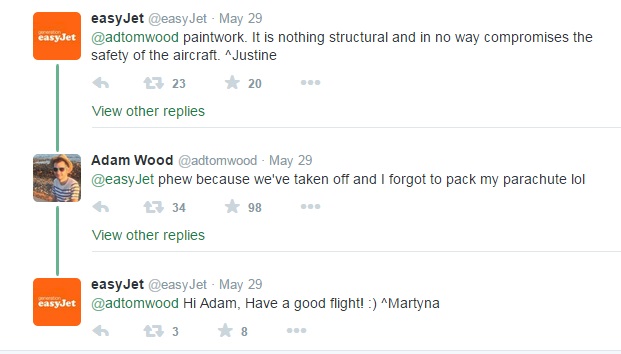The Incident
Flying is not something humans are naturally comfortable with. Many of us are also instinctively afraid of heights. As such, some of us refuse to get on a plane; others do it apprehensively — and some look out of the window and see an engine being “repaired with duct tape”.
This sight can trigger two reactions: an understandable fear for one’s own safety, and the need to tweet about it to let everyone know.
Always worrying when @easyJet are duct taping the plane together :-s #finaldestination pic.twitter.com/daYKgR9ssp
— Adam Wood (@adtomwood) May 29, 2015
Quick Brand Recovery
Faced with a fast-spreading image like this, many airline teams would have probably panicked or not reacted at all. EasyJet’s team, however, executed a good recovery. The airline found out what was happening and quickly started responding to tweets and explaining the situation. By doing so it was able to limit the damage and calm the nervous passenger.
The Larger Issue
What the passenger saw was not duct tape but “speed tape”, a highly specialised material used for aircraft repairs. This tape is routinely used for temporary repairs. However, this incident highlights a larger “sensitivity” problem within the aviation industry.
By “sensitivity” we mean an overall lack of consideration for the perceptions of passengers, often driven by a technical mindset and rooted in the airlines’ boardrooms. In an age of constantly connected travellers, and ever-present smartphones, this lack of sensitivity risks undoing much of the good work done to establish our industry as a safe — some would argue safest — travel option.
Perceptions are key to decision making and as such cannot be ignored, even if the plane is, from a technical point of view, perfectly safe.
A Roadmap for Prevention
In this case, a greater focus on perceived safety could have translated into one of the following scenarios:
- The repair being performed before the passengers were allowed on board
- The usage of a privacy screen to prevent passengers from seeing the repair being carried out
- The broadcasting of an explanation over the plane’s PA system explaining what was happening to the engine
To prevent such situations from happening in the future, we recommend taking the following steps:
- Increase organisational awareness about the nature of the Connected Traveller and the importance of Brand Perception, of which safety is a crucial part. You could begin by sharing case studies such as this one or the recent Cathay Pacific diversion video within the airline.
- Further, organise internal training sessions to raise awareness of the impact that these issues can have on the airline’s image and passenger comfort.
- Provide specialised training in Contingency Management to senior management, and at all levels of the airline’s Communications and Marketing.
- Prepare contingency plans to be able to react when images like this are shared.
Do share your thoughts in the comments below, or tweet us @simpliflying. To learn more, You could also write directly to the author at marco@simpliflying.com.
![[Case Study] Contingency Management in the Age of the Connected Traveller — EasyJet and the Engine Repaired with Duct Tape](https://simpliflying.com/wp-content/uploads/2023/04/easy-jet-duct-tape-brand-recovery-contingency-management.jpg.webp)

